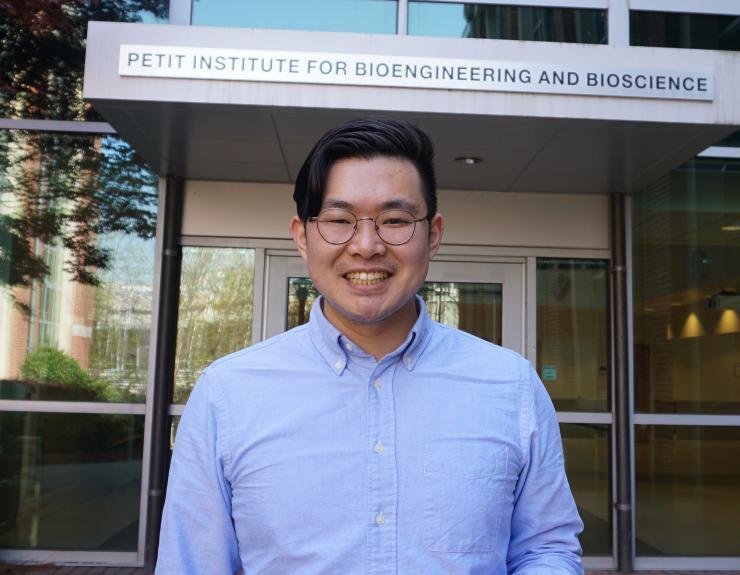Timothy Lee Wins Nerem Travel Award
Apr 23, 2019 — Atlanta, GA

Timothy Lee
Timothy Lee, a graduate research assistant in the lab of Petit Institute of Bioengineering and Bioscience faculty researcher Craig Forest, is the winner of the 2019 Nerem International Travel Award, which he is using at this very minute.
Lee, in the final year of his Bioengineering (BioE) Ph.D. studies at the Georgia Institute of Technology, has spent most of April abroad. The first part of that is two weeks in Bonn, Germany, at the Center for Advanced European Studies and Research (caesar), a neuroscience research institute associated with the Max Planck Society.
He also attended the Max Planck/HHMI Connectomics Meeting in Berlin (April 14-17), joining his collaborator and Petit Institute faculty researcher Eva Dyer, who was invited to speak at this annual gathering of thought leaders in the growing field of high-resolution connectomics, which has become Lee’s area of interest, within his focus on neuroscience and neuroscience technologies.
Connectomics (previously known as hodology) is the study of connectomes, which is kind of like a wiring diagram for the brain. Researchers in connectomics study this complex synaptic network, comprised of billions of interconnected neurons with the intention of providing a deeper understanding of brain function and dysfunction.
Lee went to Bonn to study with Kevin Briggman, “who has been pioneering this field,” Lee said. “He looks at thinly sliced neural tissue at an incredible resolution, down to nanometers, below light resolution.”
Briggman and his colleagues image each section of neural tissue with a scanning electron microscope (SEM) at high resolution, revealing fine structural details.
“One of the reasons I wanted to work with Dr. Briggman is, his lab has one of the world’s latest and greatest scanning electron microscopes,” said Lee, who has worked extensively on the more traditional transmission electron microscope (TEM). Both platforms have their strengths.
With TEM, the microscope fires a broad, static beam of electrons through a specimen, producing a magnified, flat (two dimensional) image. With SEM, the beam is focused to a fine point, and can produce 3D images. TEM has better resolution, but samples must be cut thinner, so SEM allows for a large amount of sample to be studied at once, while TEM allows for a smaller amount. Essentially, Briggman and his team are using an advanced, SEM to bring more size and clarity to the connectome, the brain’s wiring diagram.
“I’ve been working on a project that deals in this technology space, so I’m very interested in collaborating with Dr. Briggman,” says Lee, who is also looking for potential post-doctoral research opportunities.
Lee works in the lab of Forest, who is an associate professor in both the Woodruff School of Mechanical Engineering and the Wallace H. Coulter Department of Biomedical Engineering. He and Dyer were part of the research team, with Forest, that produced last fall’s paper, “Large-scale neuroanatomy using LASSO: Loop-based Automated Serial Sectioning Operation,” published in the journal PLOS ONE. Lee was the lead author.
Lee also recently was honored with a CTL Curriculum Award (part of the annual Georgia Tech Faculty and Staff Honors program). He was one of 15 people from the Petit Institute to win one of the annual awards.
This is the 14th year of the Nerem Travel Award, created by the friends and colleagues of the Petit Institute’s founding director, Bob Nerem, to honor his career of contributions in the field of bioengineering, and his dedication to the Petit Institute. The annual award of up to $3,000 supports travel and living expenses for post-docs and graduate students traveling outside the U.S. as part of their research training.
To date, this award has allowed winners an opportunity to travel and study at institutes such as Karolinska Institute, Sweden; RIKEN Brain Science Institute, Japan; the National University of Singapore, Singapore; the University of Twente, Netherlands; Weizmann Inst of Science, Israel; Queensland University of Technology, Australia; and now, caesar in Bonn, Germany.
Jerry Grillo
Communications Officer II
Parker H. Petit Institute for
Bioengineering and Bioscience




